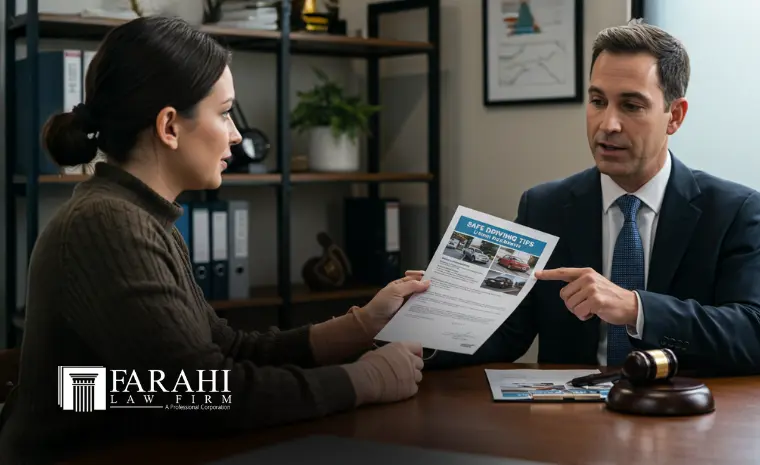Summary
U-turn accidents pose serious dangers for California drivers. This guide outlines where U-turns are legal, safety tips to prevent collisions, defensive driving strategies, and steps to take after an accident. Learn about your legal rights, common causes, and how injury attorneys can assist in protecting you after a crash.
Table of Contents
A single wrong turn can change everything. In California, U-turn accidents occur on busy streets like Van Nuys Boulevard in Panorama, CA, where drivers misjudge traffic or ignore safety rules. These crashes may involve car accidents, motorcycle accidents, or even Uber and Lyft crashes.

Victims can suffer personal injuries, property damage, and emotional distress. Knowing where U-turns are legal and how to stay safe is essential. This article covers California’s traffic laws, defensive driving tips, and steps to take if you’re involved in a vehicle accident.
Where Are U-Turns Allowed or Prohibited in California?
California law is clear about when U-turns are legal:
At Traffic Signal Controlled Intersections (Vehicle Code §21451):
- Allowed at intersections with green lights or green arrows unless a sign prohibits them.
- Must yield right-of-way to vehicles already in the intersection and pedestrians.
General Requirements (Vehicle Code §22100.5):
- Must be made from the far left-hand lane available.
- Only when it is safe and visibility is clear.
U-turns are PROHIBITED:
In Business Districts (Vehicle Code §22102):
- Prohibited in business districts unless at an intersection or marked opening on divided highways.
In Residential Districts (Vehicle Code §22103):
- Prohibited in residential districts when another vehicle is approaching within 200 feet, except at controlled intersections.
On Highways (Vehicle Code §22105):
- Prohibited when visibility is not clear for at least 200 feet in both directions.
Other Restrictions:
- At railroad crossings
- Across double yellow lines that are two or more feet apart
- Where signs specifically prohibit them
These rules exist to protect motorists and pedestrians. Violating these laws can lead to citations, increased risk of a car crash, and complicated legal issues if an accident occurs.
Safety Tips for Making Legal U-Turns
Drivers who want to avoid U-turn accidents should follow these safety tips:
- Always signal before turning.
- Check for pedestrians and cyclists.
- Make the turn only when visibility is clear for at least 200 feet.
- Avoid sudden stops mid-turn.
- Never assume other drivers will slow down for you.
Practicing the duty of care protects you and everyone on the road. It involves taking reasonable actions—like following traffic laws and staying attentive—to prevent harm to others.
Defensive Driving Around U-Turns
Even if you follow all the rules, other drivers may not. Here’s how to stay safe when near someone attempting a U-turn:
- Maintain a safe distance in case they hesitate or stop suddenly.
- Slow down when approaching intersections with high turn activity.
- Expect unpredictable movements, especially from distracted drivers.
- Be cautious at night or near poorly lit streets in Panorama, California.
🔔 Reminder: Always wear a seatbelt; if you’re riding a motorcycle or bike, wear a helmet to reduce the risk of serious injuries. These precautions lower the risk of becoming a victim of motor vehicle accidents.
Road Design and Signage: How They Affect U-Turn Safety
Not all accidents are caused by careless drivers. Poor road design and missing signage also increase risks:
- Intersections without clear markings
- Faded or hidden “No U-Turn” signs
- Inadequate lighting at night
- Narrow median openings that encourage unsafe turns
Studies show that traffic signs are key to driver behavior and road safety. Larger and brighter signs improve recognition speed and accuracy, while clear combinations of signs help drivers process information faster.
Better sign design can reduce errors and enhance safety during maneuvers like U-turns. When local governments fail to maintain safe roadways, accident lawyers may hold them accountable in a personal injury claim.
Steps to Take After a U-Turn Accident
If you are injured in a U-turn collision, knowing what to do immediately can protect your rights and strengthen your case:
- Medical Attention – Prioritize your health first, even if injuries seem minor.
- Call 911 – Request Police Reports for official documentation.
- Exchange Information – Collect driver details, witness contacts, and photos.
- Document Losses – Track medical expenses, lost wages, and Property Damage.
- Contact Legal Help – Contact a personal injury attorney or accident attorney for guidance.
These steps are crucial when dealing with an insurance company or preparing a personal injury claim.
We Help Accident Victims Rebuild Their Lives
U-turn accidents can leave victims struggling with medical expenses, lost wages, and ongoing emotional distress. If you’ve been injured in Panorama, you deserve strong legal representation from experienced accident lawyers.
Whether you need guidance from injury attorneys or support in filing a claim, Farahi Law Firm is here to help. Consult the best car accident lawyer in Panorama today for a free case evaluation and discover how to pursue your recovery.
📞 Call now to speak with our car accident lawyers.
Get the Medical Treatment You Need and the Money You Deserve
FAQs
No. U-turns are legal in some areas, but prohibited at railroad crossings, divided highways, and places with posted restrictions. However, U-turns may be allowed on divided highways where openings are provided.
Seek medical attention, call the police, document the scene, and consult with car accident lawyers to protect your rights.
Yes. Lack of signage, poor lighting, and dangerous road layouts may increase the risk and complicate legal issues.
Yes. Personal injury attorney services help navigate complex insurance company negotiations, pursue compensation for personal injuries, and provide legal representation.
Depending on the case, drivers, municipalities (for poor road design), or even companies in Uber and Lyft accidents may share responsibility.



